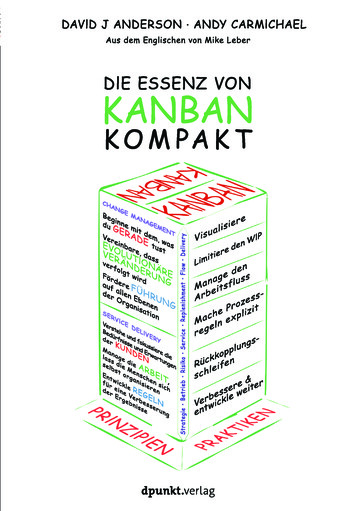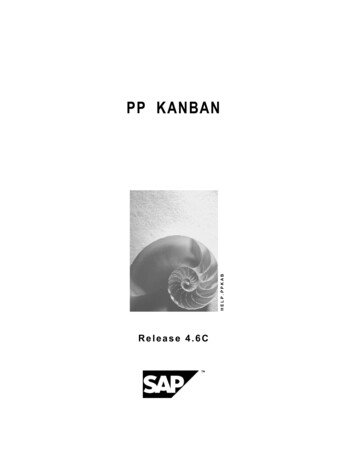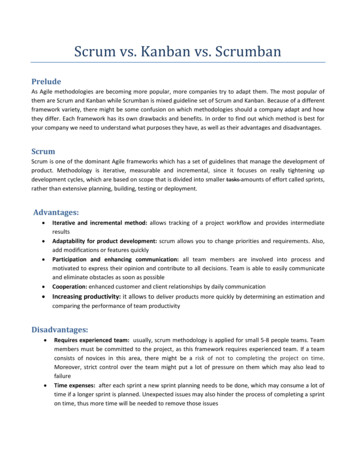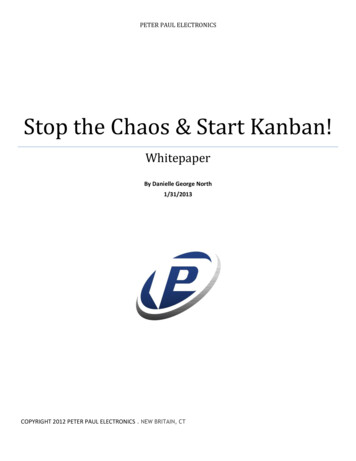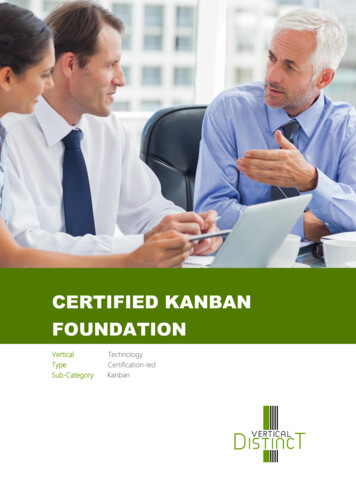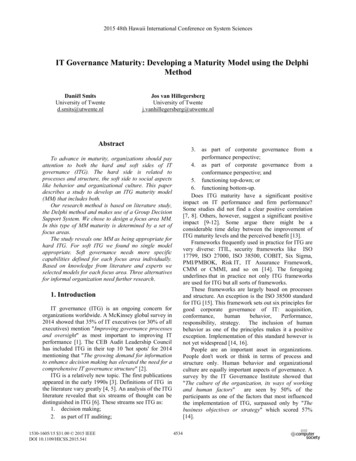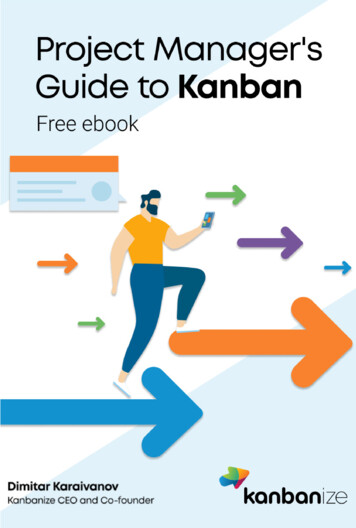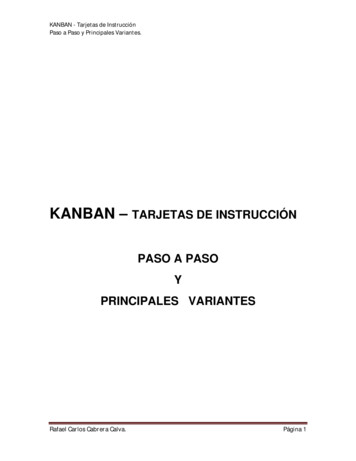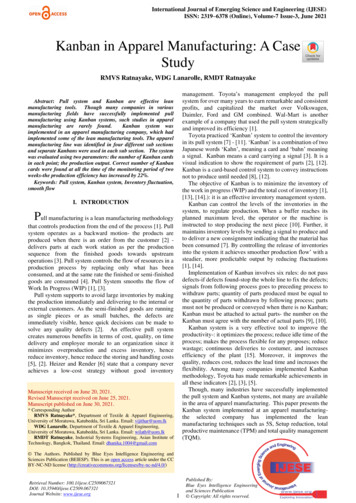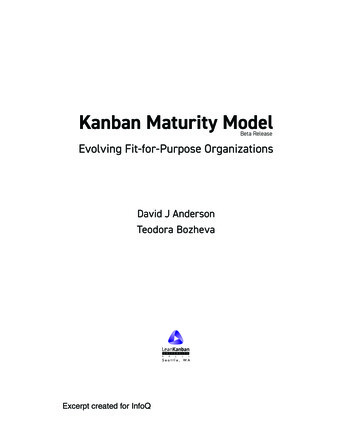
Transcription
Kanban Maturity ModelBeta ReleaseEvolving Fit-for-Purpose OrganizationsDavid J AndersonTeodora BozhevaSeattle, WAExcerpt created for InfoQ
Kanban Maturity Model: Evolving Fit For Purpose OrganizationsCopyright 2018 Lean Kanban University PressISBN: 978-0-9853051-1-6First Print Edition, 7 April, 2018.All rights reserved under International and Pan-American Copyright Conventions. Published byLean Kanban University Press, Seattle. This publication is protected by copyright, and permissionmust be obtained from the publisher prior to any reproduction, storage in a retrieval system, ortransmission in any form or by any means, electronic, mechanical, photocopying, recording, orlikewise.CMMI and Capability Maturity Model Integration are registered trademarks of the CMMI Institute.Personal Kanban is a registered trademark of Modus Cooperandi, Inc.Contact info@leankanban.com for rights requests, customized editions, and bulk orders. Additionalprint copies of this and other Kanban publications can be purchased via leankanban.com/shop.Library of Congress Cataloging-in-Publication DataTo comePrinted in the United States.
Contents1Part I The ModelKanban Maturity Model OverviewPurpose 3Influences and Integrations 4Intended Users and Needs Addressed2334Understanding Kanban Maturity Levels 7Maturity Level 0 – Oblivious 8Maturity Level 1 – Emerging 9Maturity Level 2 – Defined 12Maturity Level 3 – Managed 15Maturity Level 4 – Quantitatively Managed 19Maturity Level 5 – Optimizing 21Maturity Level 6 – Congruent 23Benefits 25Developing Organizational Agility and Adaptability 25Establishing Shared Purpose 27Fostering Organizational Values 29Integration with Capability Maturity Model Integration (CMMI)Integration with Lean/TPS 33Integration with the Real World Risk Model 35Integration with Mission Command 3630vii
viiiContents4KMM Architecture 37Maturity Levels and General PracticesSpecific Practices 37Architectural Extensions 4037Part II General and Specific Practices5Visualize 43Goals 43Benefits 43Specific Practices Summary644Limit Work-in-Progress78182Manage Flow 898910Specific Practices SummarySpecific Practices Summary90Make Policies Explicit 119Specific Practices Summary 120Implement Feedback Loops 133Specific Practices Summary 134Improve Collaboratively, Evolve Experimentally 147Specific Practices Summary 148Part III Adopting KMM11How to Use the KMM and Why 165Resistance to Practice Adoption 165References 171Index of KMM Practices 173About the Authors 179
2Understanding KanbanMaturity LevelsThe Kanban Maturity Model features seven levels, numbered 0 through 6. For consistencyand ease of adoption by technology organizations already familiar with CMMI, levels 1through 5 are aligned to the five levels of CMMI, with a slight difference in the naming ofmaturity levels 1, 2, and 3. We have found it useful to extend the model above and belowthese five stages. The additional levels are inspired by Jerry Weinberg’s maturity modelfrom his Quality Software Management, Volume 1: Systems Thinking[6].Level 0 is introduced to model individuals and organizations that are simply obliviousto the need for a process or managerial method. We observe such nascent, immature businesses in our case-study literature. They come to us when they have the epiphany that iftheir business is to survive and thrive, they do need a process, often choosing Kanban as ameans to some management oversight with very little process overhead. Kanban providessome constraints without constraining the emergence of processes and workflows specificto their business.Level 6 is introduced to provide for double-loop learning where an organization is questioning, Who are we? Is our identity still appropriate? and if not, Who do we want to be?How should we reinvent ourselves? What is our purpose to exist, and is it still relevant? Isour strategy appropriate? Do we offer the correct products and services? Are we choosing toserve the correct market segments, or do they need to change? How should we evaluate andidentify market segments to target? Which existing segments should we drop?We feel that this seven-level model offers a considerable advance and innovation overprevious organizational maturity models, while maintaining continuity with models thathave preceded it. We believe that our new model will better serve the pursuit of excellencein product and service delivery and encourage behavior for adaptability and long termsurvival of businesses. The following chapters describe each level in detail.7
8Understanding Kanban Maturity LevelsMaturity Level 0 – ObliviousAt maturity level 0, individuals are responsible for handling their own tasks. Frequently,the person who performs the work is the user of its outcome as well; that is, the work isself-generated tasks rather than customer requested work orders.Observable behaviorThe organization is oblivious to the need to follow a process. There is ambivalence about thevalue of management or organizational processes or policies. There is no collaborative working or, if there is, there is no recognition of collaboration. Collaboration may be fleeting, onan ad hoc basis without recognition of a pattern or repeated need. There is no concept of “ateam”—a group of people who work collaboratively to deliver on a common goal.The quality and consistency of work done, or services performed, is entirely associatedwith individuals and their capabilities, skills, experience, and judgment. The organization,and its performance, is extremely fragile to changes in personnel.There is no instrumentation, as there is no defined process to instrument. Metrics andmeasures are not present.Decision making tends to be reactive, emotional, spontaneous, and sometimes difficultto explain.Observable Kanban patternsAt maturity level 0, the focus is completely on handling personal tasks. Therefore, theobserved Kanban patterns include three main types of Personal Kanban2 boards, used primarily to visualize tasks. The designs observed reflect a growing level of personal maturityand capability at self-management. There is an intention to achieve a level of self-improvement using reflection, and often a cadence emerges as the use of personal kanbanbecomes habitual (Figure 1).A trivial personal kanban visualizes invisible work, relieving the user of the burden ofcarrying the list of open tasks in their head. A simple personal kanban introduces WIPlimits and recognizes a limit to human capacity, a desire for relief from overburdening,and a belief that multitasking causes individual tasks to take longer and their completionto be unpredictable. This second level could be described as a result of the epiphany thatit is better to “stop starting, and start finishing.” The consequence is a feeling of personalachievement. The true personal kanban emerges when individuals realize that there is anexistential overhead to a large backlog of unstarted tasks. This third, more mature designincludes the act of personal commitment to items that will be done next, while there isrecognition that backlog items are actually uncommitted, remain optional, and may bediscarded. There is often a cadence to the personal reflection needed to select that which2. Personal Kanban is a registered trademark of Modus Cooperandi, Inc.
Maturity Level 1 – Emergingwill come next. A personal triage capabilitydevelops to decide what will be done: now;later, and if later, then roughly when, basedon a sense of urgency of the task; or not atall.From an organizational maturity perspective, this third style of board is still amaturity level 0 (ML0) pattern; however, itreflects the thinking and actions of a moremature individual likely to want to participate in a more mature organization.Maturity Level 1 – EmergingAt maturity level 1, there is recognitionthat management adds value and that someorganizational structure and transparencyto how work is done will offer consistency.Emerging covers a wide range of aspectsof process, management concepts, and behavior. At the lowest level, there would beno definition of processes, procedures, orworkflows. However, some collaborativework will be happening. There is someform of “value-stream” rather than mereindividual craft work taking place.As maturity grows, some initial definition of process workflows, managementpolicies, and decision frameworks emerge.Process definition is “emerging.” However,processes, workflows, and policies are notfollowed consistently and the use of decision frameworks is also inconsistent.Observable behaviorThere is no consistency of process, policyusage, or decision frameworks. There is noFigure 1 ML0 Kanban patterns9
10Understanding Kanban Maturity Levelsconsistency of desired outcome. Work is not seen as a combination of services, and customersperceive service delivery as unreliable.There is an understanding of what the work is, but perhaps not how it should be done,what the finished product should look like, or the service delivery expectations of customers. There is little understanding of who the customer is or why they have requested thework. Consequently, there is an observable lack of alignment among teams. This affectsthe consistency of product design and implementation as well as service delivery.Work is pushed into the process. Priority is set based on superstition, or political leverage, or is purely ad hoc and random. The process, system, or value stream is overloaded.Individuals are often overburdened. There is no concept of a capability or a capacity tothe system. Hence, it is impossible to try to balance demand against capability. There isan expectation that everything requested will be done. There is no triage capability oropportunity to refuse work.Analogously, if we were in the pizza delivery business, we would observe that themethod of preparing, baking, and delivering pizza was inconsistent and that defined procedures were not followed consistently. We would also observe that often the pizza delivered was of the wrong type, missing ingredients, or of poor quality upon delivery; or thatthe delivery time varied dramatically. The customer experience would be to conclude thatthe vendor is extremely unreliable.The workplace is stressful because of the inconsistency and poor quality, and there aresignificant amounts of rework. There is constant pressure to find new customers becauseexisting customers, reacting to the unreliable service, fail to return.There is considerable luck attached to whether a product or service is “fit-for-purpose.”There is a reliance on individual heroics.Collaboration and the concept of teams is recognized. However, organizational capability and performance is extremely fragile and there is a tendency to rely upon and rewardheroic effort and heroic individuals. Customers with sufficient transparency will show apreference or demand the involvement of specific individuals on their work requests as ameans to mitigate risks of inconsistent, poor performance and disappointment.It is highly likely there is loss of discipline when under stress and handling exceptionalcircumstances. When stressed, the organizational maturity is likely to slip back to level 0,and the organization relies entirely on individual heroics to pull out of the crisis.Some metrics may be present, though these tend to be focused on individuals ratherthan on instrumenting still emerging and inconsistently followed processes. There is atendency to collect and report that which is easy to measure and there is little thought asto whether the measure is useful or actionable. Some local activity measures may serve asgeneral health indicators, though many may be of little actionable value and are essentiallyvanity metrics—they make a team or its individual members feel good, feel as if they aremaking progress, but they serve no meaningful purpose in improving business outcomes.
Maturity Level 1 – EmergingDecision making is emotionallydriven and superstitious in nature.Observable Kanban patternsAt the transition to the level 1 stage,several individuals are working on acommon function, but assignments areseparated. There may be specializationof tasks to individuals with specificskills. Everyone is responsible for organizing and performing their own tasks,or tasks are assigned and dispatched bya supervisor.An aggregated personal kanbanboard (Figure 2) is used to visualize allthe tasks and their status for a department or function, typically using onelane per person. Hence, each lane is apersonal kanban board, and displayedtogether they are aggregated. This design often facilitates the “supervisor asdispatcher” who assigns tasks to individuals. However, having awarenessof what the other people do and withwhich work they may require assistance,fosters collaboration. It is the first stepto creating a team and developing theunderstanding that working jointlyproduces better results more efficientlythan working in isolation with limitedcomprehension of how one’s work affects others.At the core stage of maturity level 1,collaboration happens habitually ina small team performing work with ashared goal or shared responsibility andaccountability. Pools of people with different specializations may exist. Eachteam member is still responsible forFigure 2 ML1 Kanban patterns11
12Understanding Kanban Maturity Levelshandling their own tasks; however, the team has an emerging comprehension of the overall development process, in particular how it begins and ends. This lays the foundation formaturity level 2, at which teams start seeing their jobs as a service conducted in responseto a customer request or as a part of a larger workflow. Therefore, maturity level 1 is fundamental for making Kanban Service Delivery principles one and two work:1. Understand and focus on your customer needs and expectations.2. Manage the work, let people organize around it.The team visualizes its work and meets daily to check its status. However, the processis not consistent yet, and under stress it is likely to lose discipline and consistency. Performance depends almost totally on the availability and individual efforts of the team members and varies as widely as the spread in individual capabilities across the team.Maturity Level 2 – DefinedAt maturity level 2, there is a basic definition of processes, workflow, policies, and decision frameworks. These are followed consistently. There is recognition that the processdefinitions describe “the way we do things.” However, there is still a lack of consistency inthe desired outcome. Customers will observe unacceptable inconsistencies in quality andservice delivery, though less so than at maturity level 1.Observable behaviorThe process, policy usage, and decision frameworks are consistent. However, there is stillno consistency of the desired outcome.There is an understanding of what the work is, and both how it should be done andwhat the finished product should look like, as well as the service delivery expectations.There may not be a full understanding of who the customer is or why they have requestedthe work. This is most often true for shared and internal services that lack visibility to theend customer and the motivation or purpose behind a work request or the risks associatedwith that work or its delivery. As a consequence, there may be an observable lack of alignment among teams and interdependent service workflows. This affects the consistency ofservice delivery as seen by the customer.A basic understanding and definition of the workflow is developed. Nevertheless, worktends to be pushed into the process because policies are not strong enough or sufficientlyinternalized as to prevent it. There is little observable capability to prioritize work. Priority, if it exists, may be superstitious, political, or simplistic, such as first-in-first-out. Theprocess, system, or value stream tends to be overburdened. There is a tendency to say “yes”to everything or too many things and an inability to balance demand against capability.
Maturity Level 2 – DefinedIf we were in the pizza delivery business, we would observe that the method of preparing, baking, and delivering pizza was consistent and that defined procedures were nowfollowed consistently. However, we would still observe that the pizza delivered was occasionally of the wrong type, missing ingredients, or of poor quality upon delivery; or thatthe delivery time differed dramatically from expectations. The customer’s perception stillwould be that the vendor is unreliable.There is increased collaboration that now spans across teams and facilitates workflow.The workplace is notably less stressful because of the consistency of process and definedroles and responsibilities. Workers know what is expected of them and what they canexpect of their colleagues. Poor quality is still an issue, though less so than at level 1, andthere is still some rework. There is still some pressure to find new customers because someexisting customers fail to return as a reaction to the unreliable service.The product or service is often not completely “fit-for-purpose.” There is a reliance online-level managerial heroics to ensure consistency and the meeting of expectations. Thereis a tendency to reward and venerate heroic managers.Organizational capability and performance remains fragile. Customers may demandthe involvement of specific managers, whom they trust, to mitigate risks of inconsistent,poor performance and disappointment.There is some tendency to lose discipline when under stress and handling exceptionalcircumstances. When stressed, the organizational maturity tends to slip back to level 1.There is rudimentary instrumentation of the defined process. There may be a tendencyto measure and report that which can be seen or is easy to instrument. There is little or noalignment of reported metrics with customer expectations. Metrics and measures tend tobe locally focused on performing the work, such as cycle times or throughput rates on specific activities or value-adding steps. Most measures are general health indicators, thoughsome may be of little actionable value and should be seen as vanity metrics.Decision making is usually qualitative in nature or emotionally driven.Observable Kanban patternsThe main characteristics of the transition from the Emerging to the Defined maturitylevel is the usage of the Defined workflow with per-person WIP limits on the kanbanboard (Figure 3). Here, a sequence of the main workflow phases substitute for the genericIn-progress column of team kanban boards. The types of work are identified and visualizedby different colors (in this example) or by different lanes across the board.The team begins to understand that their performance depends on the amount ofwork-in-progress; that is, the more work-in-progress, the longer work takes and theless predictable its completion. There is recognition that work left unfinished in a waiting state is not helpful and can lead to much higher defect rates and increased rework.13
14Understanding Kanban Maturity LevelsFigure 3 ML2 Kanban patternsNevertheless, teams using delivery kanban boards with per-person WIP limitsdeliver better quality results and feelrelief from overburdening.Although the workflow is still basicand the overall process is not consistentat the transition stage, there is emergence of customer focus. There is anunderstanding that work flows througha series of steps toward completion ofsomething of customer value. It is realized that smooth flow of work is a desirable state for relief from unevenness.Unevenness in arrival of work createstemporary periods of overburdening.Unevenness in flow makes predictabledelivery challenging and has a directeffect on customer satisfaction. Thereis growing appreciation and awarenessof more of the Kanban Method’s values, but values such as “customer focus”and “balance” are not yet fully embraced and the cultural focus remainsinward—“who we are” and “what’s in itfor us.” Improvements are justified onselfish grounds at the team level. Thereisn’t yet an outward-looking altruism ora focus on contributing for the benefitof customers and other stakeholders.The need to properly coordinate theteamwork (mainly among differentspecializations) appears to avoid peaksand troughs of workload.At the core stage of maturity level 2,organizations are better able to coordinate activities with different audiencesand decouple the cadences of planning,committing, or selecting work from thecadence of delivery. This reduces the
Maturity Level 3 – Managedeffect of losing rhythm due to concentrating team effort on packaging and handing overcompleted work and then restarting development. In addition, developing the ability toallow work to be in-progress while a delivery is being made requires strengthening othertechnical capabilities such as configuration management. Hence, decoupling the rhythmof planning, commitment, doing, and delivering creates positive stress to improve specificenabling practices such as configuration management.Some teams recognize the need to control the workflow and do it by using a deliverykanban board with a defined commitment point and constant WIP (CONWIP), whichis a true pull system, but without a defined workflow. Basic policies for prioritizing, committing work, and visualizing work status are established. Parameters like % Complete areintroduced and are used to provide additional information about project status and trackits conformance to plan. Portfolio kanban boards are used for visualizing the status ofmultiple projects and making relevant decisions.Nevertheless, the workflow management responsibility is not explicitly defined. Evenin organizations with established project management processes, project managers’ dutiesinclude planning, monitoring, and controlling project activities against plan but not managing the workflow. There is no one playing the service delivery manager (SDM) role. Insome organizations, we’ve observed the emergence of a “flow manager” role at maturitylevel 2. This role tends to have an internal focus, actively managing flow for its benefit ofrelieving temporary overburdening due to unevenness.At this level, established policies and workflow controls do not enable managing unforeseen events. This is because the feedback from the system is insufficient. Behavior is entirelyreactionary. As a consequence, unforeseen events caused by the occurrence of specific risksor more complex situations, for which there is no specific guidance on how to handle them,can take a project or a service out of control. The result is a failure to meet expectations and,often, a regression in observed maturity level to a more individualistic, heroic culture.Maturity Level 3 – ManagedAt maturity level 3, there is an agreed and understood definition of processes, workflow,policies, and decision frameworks. These are followed consistently, and, in addition, desired outcomes are achieved consistently within customer expectations and tolerances.Observable behaviorThere is a consistency of process, policy usage, or decision frameworks. There is now aconsistency of desired outcome. Customer expectations are being met. Product design,quality, and service delivery are all within customer expectations and tolerance levels.There is an understanding of what the work is—both in how it should be done andwhat the finished product should look like—as well as the service delivery expectations.15
16Understanding Kanban Maturity LevelsThere is a strong sense of unity and purpose along the value stream or across the workflow.There is a sense of a team collaborating to deliver a piece of work. There is a full understanding of who the customer is and why they have requested the work. There is a strongsense of fulfilment amongst the workers when delivering finished work.There is an observable triage capability to prioritize work into three categories: (1) doit now; (2) leave it until later, comprehending when is ideal; (3) discard, reject, do not doit. Demand is balanced against capability and the system is relieved of over-burdening.If we were in the pizza delivery business, we would observe that the method of preparing, baking, and delivering pizza was consistent and that defined procedures are followedconsistently. Pizza is delivered consistently, correctly to request with high quality, andwithin service delivery expectations. The customer perception is that the vendor is veryreliable.The workplace runs very smoothly under both normal and exceptional circumstances.There is little tendency to panic under stress. There is a strong sense of process, roles, andresponsibilities, and workers know how to react to unusual or exceptional circumstances.There is little urgency to find new customers because existing customers provide steadydemand.The product or service is now completely “fit-for-purpose.” There is now an absence ofheroics. Instead there is reliance on defined methods, processes, and decision frameworks.When things don’t go as planned there is action taken to revise methods and proceduresrather than blame individuals.Organizational capability and performance is now resilient. Customers now trust thatwork is done consistently and there are no specific requests for individual personnel orspecific managers.The organization is now thinking explicitly about services from an external customerfacing perspective. The notion that the organization consists of a network of interdependent services is starting to emerge. There is some recognition of the power and efficiencyof effective shared services.The process is instrumented to collect and report customer fitness criteria metrics. Theremay be improvement driver metrics present and actively in use. Metrics and measurestend to be end-to-end, with only specific improvement drivers focused on local activitiesor value-adding steps. There is a clear metrics and reporting strategy with fitness criteria,improvement drivers, and general health indicators being used appropriately. Presence ofvanity metrics is unusual and may exist for cultural reasons, or may be explained as evolutionary relics to which there is an emotional attachment and the conditions needed tosuccessfully remove them have not yet materialized.Despite the considerable instrumentation and availability of metrics, decision makingremains mostly qualitative or emotionally driven.
Maturity Level 3 – Managed17Observable Kanban patternsFigure 4a ML3 Kanban patternsA key characteristic of a maturity level 3transition organization is the usage ofkanban systems that visualize a service-oriented, customer-focused workflow. An aggregated team kanban boardis used to visualize workflow across different teams (Figures 4a and 4b ).Pull criteria, work item dependencies,defect/rework, and blocked work itemsare consistently visualized. This facilitates the deeper understanding of thesystem that performs the work. Initialactions for stabilizing the workflow arein place, in particular, establishing WIPlimits for different states and for the entire system, as well as through plottingand interpreting the Cumulative FlowDiagram.Replenishment Meetings are heldto move work items over the commitment point and control the workload toavoid destabilizing the entire system,although the customer might still tendto push starting work in spite of thepull criteria defined by the team.The processes are repeatable and theteams follow their routines, althoughthey can still abandon them in crisis.At core stage of ML3, managersand teams have developed a good understanding of the workflow based onexperience, collected historic data, andestablished feedback mechanisms (delivery planning, service delivery, andRisk Reviews). They make decisionsusing recent information about what isactually happening. In addition, they areable to flexibly manage work in order
18Understanding Kanban Maturity Levelsto effectively deliver expectedresults. Policies and processesare respected by managers andteams and are followed even incrisis.The deeper understandingof the workflow allows managing larger and riskier projects with a greater degree ofsuccess. Multiple project andservice management is in placeand dependencies betweenprojects and services are takeninto account. Initial Operations Reviews are conducted tounderstand and address servicedependencies.Higher level managementis convinced of the benefitsbrought by properly managing work. The roles of servicerequest manager and servicedelivery manager are introduced to ensure correct management both upstream anddownstream.Figure 4b ML3 Kanban patternsWorkflow data is collectedand plotted to charts. Althoughdata quality is not very good yet and the entire process is not stable enough to producemeaningful measurements, the available data provides information that allows comparingactual and desired project/service state and definition of relevant actions. Analyzing datafacilitates the understanding of the processes and starts developing a culture of making decisions based on quantitative information.Delivery Planning Meetings are held to plan deliveries to customers and to make specificdelivery date commitments. The act of committing to doing something is separated fromthe act of committing to a specific date for delivery. In doing so, customer expectations arebetter managed and service delivery effectiveness improves. Service Delivery Reviews areconducted to monitor and improve service effectiveness. Risk Reviews are conducted tounderstand and respond to the risks that impede effective delivery of services.
Maturity Level 4 – Quantitatively ManagedMaturity Level 4 – Quantitatively ManagedAt maturity level 4, design, implementation, and service delivery have become routinely“fit-for-purpose.” Consistency of process and consistency of outcome have the effect ofrelieving a lot of stress, and the organization moves its focus to economic outcomes aswell as
Understanding Kanban Maturity Levels. The Kanban Maturity Model features seven levels, numbered 0 through 6. For consistency and ease of adoption by technology organizations already familiar with CMMI, levels 1 through 5 are aligned to the five levels of CMMI, with a slight
